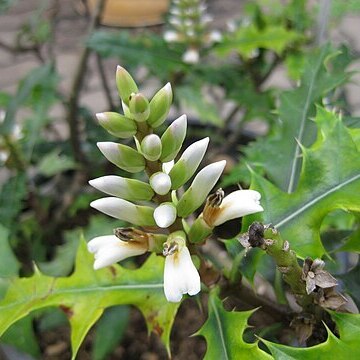Shrubs 1-3 m tall. Stems terete, stout, glabrous, often with stipulelike spines at nodes. Petiole 1-4 cm, glabrous; leaf blade oblong to obovate-oblong, 5-12 × 3-5 cm, rigid, subleathery, glabrous, secondary veins 3 or 4 on each side of midvein and spreading to spinose teeth, base cuneate, margin 3-or 4-toothed or irregularly pinnatifid, apex truncate to slightly mucronate and obtuse. Inflorescences terminal spikes to 4 cm; bracts broadly ovate, 6-7 × 4-5 mm; bracteoles absent. Calyx posterior and anterior lobes broadly ovate and 8-12 × 5-9 mm, lateral lobes elliptic and ca. 10 × 4 mm. Corolla white [blue or purplish], ca. 2.5 cm; tube basally cylindric and ca. 2.5 mm wide for 5-8 mm; lip oblong, ca. 2.2 cm; lobes oblong, outside glabrous, inside appressed pubescent. Stamens subequal; filaments ca. 9 mm; anther theca oblong, ca. 8 mm, with a line of trichomes on both sides of suture. Capsule ca. 1.8 cm. Seeds yellow, ca. 10 × 7 mm, rugose. Fl. Apr-May, fr. Aug-Sep. 2n = 44.
More
A herb or shrub. It can be erect or spreading. It grows 1.5 m tall. It has several stems. The leaves are stiff and dark green. There are spines at the end of each deep lobe. The flowers are blue, purple or white. The fruit is a square capsule. It explodes when ripe. The seeds are flat and dull white.


